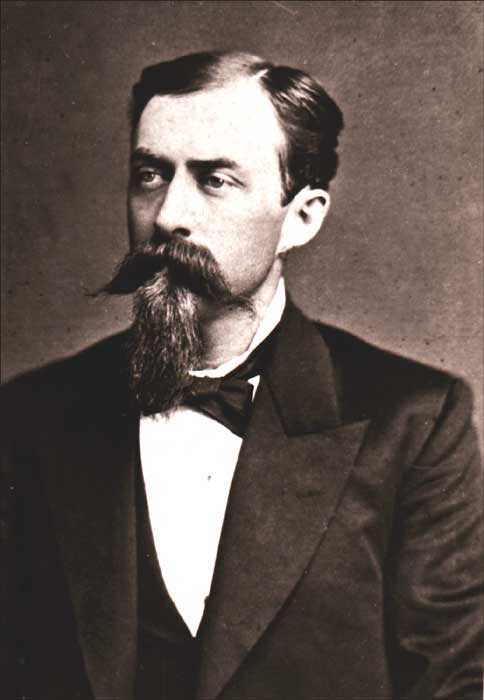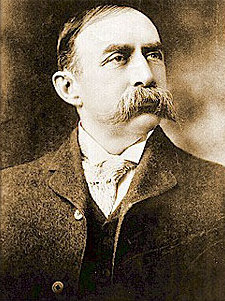
The Quiet Giant of the Texas Frontier: John Barclay Armstrong’s Enduring Legacy
In the rugged, lawless expanse of post-Civil War Texas, where the crack of a rifle often served as the only form of justice and the line between outlaw and lawman was frequently blurred, a new breed of hero emerged. Among them, few cast as long and quiet a shadow as John Barclay Armstrong. A man of few words but formidable action, Armstrong carved his legend not with flamboyant gunfights but with an unflappable resolve and an unwavering commitment to order. His name became synonymous with the burgeoning might of the Texas Rangers, a force he helped shape into the iconic institution it remains today, forever etched in history for his pivotal role in bringing down one of the era’s most notorious villains: John Wesley Hardin.
Born in 1850 in McMinnville, Tennessee, Armstrong’s early life offered little hint of the legend he would become. The son of a farmer, he was raised in a time of profound national upheaval. Like many young men of his generation, he was swept into the maelstrom of the Civil War, serving briefly with the Confederate forces in his youth. The war’s end left a fractured nation and, particularly in Texas, a chaotic frontier. Outlaws thrived, cattle rustling was rampant, and Reconstruction-era politics bred resentment and instability. It was into this crucible of disorder that the young Armstrong, seeking purpose and a future, migrated to Texas.
He initially worked as a cowboy, honing the skills of horsemanship, tracking, and self-reliance that would prove invaluable in his later career. But it was the call to a higher purpose, the desperate need for order, that drew him to the nascent Texas Rangers. In 1875, at the age of 25, Armstrong joined Company B of the newly formed Frontier Battalion, commanded by the legendary Captain Leander H. McNelly. McNelly was a hard-bitten, fiercely effective leader, and he quickly recognized in Armstrong a rare combination of courage, intelligence, and an almost stoic determination. "Armstrong is a man who fears nothing," McNelly is reported to have said, a testament to the young Ranger’s character that would soon be proven true in the face of immense danger.

The Frontier Battalion was an audacious experiment. Tasked with bringing law to a territory larger than many European nations, McNelly’s Rangers were often outnumbered, undersupplied, and operating in hostile terrain. They were the "thin green line" against a tide of lawlessness, and Armstrong quickly distinguished himself. He was not a showman; his effectiveness lay in his quiet efficiency, his ability to track relentlessly, and his willingness to confront danger head-on. His reputation grew with each successful raid on rustlers, each capture of a bandit, each step taken to assert the authority of the law where none had existed before.
But it was the hunt for John Wesley Hardin that would elevate Armstrong from a respected Ranger to a frontier legend. Hardin, a cold-blooded killer credited with over 40 murders, was perhaps the most feared outlaw in Texas. Fast with a gun and utterly ruthless, he seemed to possess a demonic cunning that allowed him to evade capture repeatedly. His crimes spanned years, leaving a trail of blood and terror across the state. By 1877, Hardin had fled Texas, eventually settling in Florida under an assumed name, believing himself safe from the long arm of Texas justice. But the Rangers, particularly McNelly and Armstrong, had a long memory and an even longer reach.
Captain McNelly, though ailing, was determined to bring Hardin to justice. When intelligence suggested Hardin was hiding in Pensacola, Florida, McNelly dispatched his most trusted operative: John Barclay Armstrong. The assignment was fraught with peril. Armstrong would be operating deep in unfamiliar territory, without backup, against a man renowned for his deadly skill and quick temper. It was a mission that demanded not just courage, but an almost suicidal audacity.
Armstrong, accompanied by a local lawman, arrived in Pensacola and, through painstaking detective work, located Hardin. The confrontation came on August 23, 1877, aboard a train at the Pensacola station. Hardin, along with several associates, was about to depart. Armstrong, with the local sheriff’s deputy, moved in.
What followed was a moment of sheer, unadulterated grit. As Armstrong approached the train, he saw Hardin inside. With his pistol drawn, he announced, "Hardin, you’re my prisoner!" Hardin, ever the lightning-fast killer, lunged for his own weapon. Accounts vary slightly, but the essence remains: Armstrong, anticipating the move, was quicker. He didn’t shoot to kill immediately, a testament to his adherence to the law, but instead struck Hardin on the head with his pistol, knocking him unconscious. A fierce struggle ensued with Hardin’s associates, but Armstrong, with the deputy’s help, managed to subdue them all. In a single, audacious stroke, the "deadliest gun in Texas" was captured.
The news of Hardin’s capture by a lone Texas Ranger reverberated across the nation. It was a monumental achievement, not just for Armstrong but for the Rangers as an institution. It demonstrated that no outlaw, no matter how feared or how far they fled, was beyond the reach of Texas justice. Armstrong’s quiet bravery had delivered a profound blow against the forces of lawlessness. Hardin was eventually extradited to Texas, tried, and sentenced to prison. He was later killed in an unrelated shooting by another lawman, John Selman, in El Paso in 1895, but it was Armstrong’s capture that broke his reign of terror and cemented the Ranger’s legend.
Armstrong’s career with the Rangers continued to flourish. He was promoted to Sergeant and then, in 1879, to Captain, leading his own company. He participated in numerous other campaigns, including the relentless pursuit of the Sam Bass gang, another notorious group of train robbers and outlaws. While Bass was ultimately killed by another Ranger, Armstrong’s leadership and strategic mind were crucial in the relentless pressure that eventually led to the gang’s demise. He commanded his men with the same quiet authority and effectiveness that he displayed as an individual Ranger, earning their respect and loyalty.
By the early 1880s, the face of Texas was changing. The frontier was slowly being tamed, and the need for the rough-and-tumble methods of the early Frontier Battalion began to diminish. In 1881, after six years of exemplary service, Captain John Barclay Armstrong resigned from the Texas Rangers. He had played a vital role in establishing order, bringing notorious criminals to justice, and forging the reputation of one of America’s most iconic law enforcement agencies.

His post-Ranger life was as industrious and respected as his law enforcement career. Armstrong married Annie R. Kyle in 1880, and they settled down to ranching in South Texas, near the town of Armstrong, which was named in his honor. He became a successful rancher and a pillar of his community, serving a brief term as a state senator. He embodied the transition from the wild frontier to a more settled, prosperous society – the very order he had fought so hard to create.
John Barclay Armstrong passed away in 1913 at the age of 62, a relatively young age for a man who had lived such a full and dangerous life. He was buried in the family cemetery in Armstrong, Texas. His legacy, however, extends far beyond his grave.
Armstrong’s story is not just a tale of daring feats; it is a testament to the power of character. He was the embodiment of the "quiet giant" – a man whose strength lay not in bluster or bravado, but in his unwavering commitment, his cool head under pressure, and his absolute dedication to justice. He represented the best of the Texas Rangers: fearless, relentless, and utterly incorruptible.
His capture of John Wesley Hardin was a turning point, not just in Armstrong’s life, but in the history of Texas. It signaled the end of an era where outlaws could rule with impunity and ushered in a new chapter where the law, however slowly and painstakingly, would prevail. Today, the Texas Rangers continue to uphold the high standards set by men like Armstrong. His legend serves as a reminder that true heroism often resides not in the loudest voices or the most flamboyant actions, but in the quiet, determined courage of those who stand for what is right, no matter the odds. John Barclay Armstrong, the quiet giant, forever remains one of the true architects of the Texas frontier’s transformation, a man whose legacy echoes in every whisper of "one riot, one Ranger."


